Early Sign of Diabetes Visible in the Body Without Blood Test
What is Diabetes Mellitus
Diabetes Mellitus is a major problem in the world now a Days. Every 3 person suffer from this disease in the world. this is a hormonal disease, in this disease pancreas unable to produce and secrete enough insulin to manage glucose in blood, so increase the amount of glucose (Blood Sugar) in Blood. it effect on body organ like- kidney, heart, brain and nervous system. we identify the early sign of diabetes mellitus given below,
Early Visible Signs of Diabetes

- Excessive urination and Excessive thirst
High blood sugar increase urine output, more and more water come from inside cell cause dehydration.
2. excessive hunger and unexplained weight loss
Increase blood sugar but glucose not enter in cells and no breakdown of glucose then body depend upon fat and protein for energy so decrease fat and muscle cause weight loss and hunger.
3. Fatigue and low Energy
Decrease cellular fuel in body cause fatigue and low energy
4. Blurred vision or fluctuating vision
Swelling of the eye’s lens due to glucose enter in eye can blur your vision or fluctuating
5. Slow-healing wounds or increased infections
Person with diabetes mellitus wound healing process is very slow due to increase blood glucose level.
✅ Quick Reference Table
| Sign | What to Look For |
|---|---|
| Dry, itchy skin | Especially on legs—due to fluid loss & poor circulation |
| Dark velvety patches | Often on neck, armpits, groin—sign of insulin resistance |
| Shin spots | Brownish-red patches on shins—vessel damage indicator |
| Blisters/scleroderma-like | Painless blisters; tight waxy skin on fingers/toes |
| Yellow bumps/deposits | Xanthomas or xanthelasma—fat buildup under skin |
| Slow-healing wounds | Cuts/infections that resist healing |
| Vision changes | Blurry, fluctuating eyesight |
📝 What You Should Do
- Self-check regularly: Keep an eye on skin patches, dryness, blisters, wounds, and any vision disturbances.
- Seek prompt testing: If you notice persistent signs—especially multiple ones—request blood tests like fasting glucose or A1C.
- Consult a professional: A dermatologist or general physician can help distinguish diabetes-related signs from other skin issues.
- Preventive care: Manage diet, stay active, moisturize skin, treat cuts right away, and screen for infections early.
In summary:
if you notice dry skin, dark patches, slow healing, or vision changes, don’t wait—these are early, visible signals that could point to diabetes. Getting tested early is crucial for effective treatment and prevention.
Would you like advice on how to ask your doctor or nutritional steps to reduce risk?
